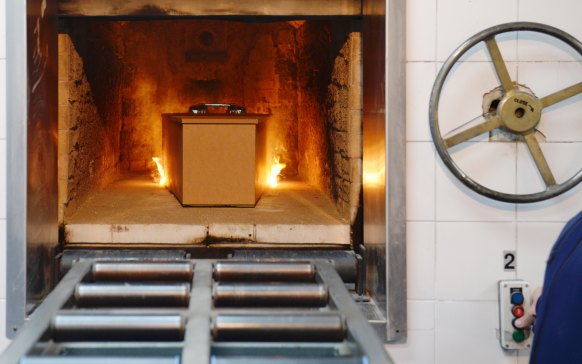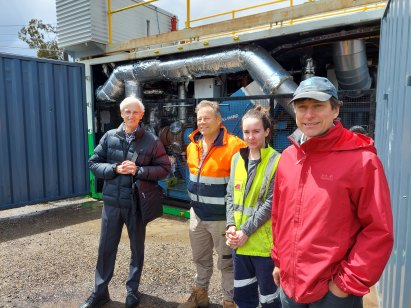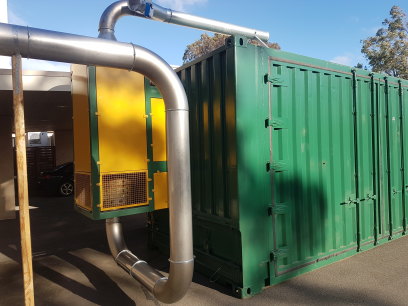- Exclusive
- Environment
- Climate change
- Renewables
Harnessed waste heat from cremations, sewage sludge could soon power our homes
By Bianca Hall
Cremating bodies is an energy-intensive process: the sheer amount of energy required to cremate an individual body can generate more than 250kW in wasted heat.
But what if we could harness that excess heat, and use it to create a renewable energy that could power our homes and businesses?

Crematoriums can use 600kW in energy to power a cremation, with more than one-third of that power disappearing up flues as waste heat.Credit: Nick Moir
An Australian start-up has completed a series of successful trials of what the team behind it says is a commercially viable electricity engine that runs on waste heat – including a successful “proof of concept” trial at a Victorian crematorium.
“Cremations are an exothermic process in that they actually give off more energy than they soak up,” said Capricorn Power chief executive Geoff Andrews.
Crematoriums can use 600kW in energy to power a cremation, with 250kW of that power considered “excess” and disappearing up flues as waste heat.
After the crematorium trial, Capricorn Power – a small start-up based in Victoria – successfully tested an updated prototype engine over 400 days on a purpose-built natural gas burner, to establish its commercial viability.

Capricorn Power’s (from left) Noel Barton, Randolph Dietzel, Sophie Bainbridge and Rowan Doyle at the testing site in Geelong.Credit: Capricorn Power
In time, Andrews said, the engines could be used to heat biological waste such as sewage “sludge”, nutshells, and biowaste from piggeries and abattoirs to more than 400 degrees, and transform it into low-emissions energy.
“There’s plenty of waste material around; enough that we can actually be stringent or fussy about not taking a resource that could have a high-value use,” he said.
The prototype Barton Engine fits inside a shipping container and, its proponents say, could be attached to businesses to take biowaste and transform it into portable energy supplies that power the business producing the waste.
“The advantage of having an engine that can be efficient and small is that you can put the generator where it’s required and where electricity is being used,” Andrews said.

This humble shipping container at a South Geelong crematorium housed a proof-of-concept engine that transformed emissions into energy.Credit: Capricorn Power
As the Albanese government’s legally binding 2030 emissions reductions targets inch closer, the independent Climate Change Authority has increased pressure on the government and every sector of the economy to reduce emissions.
The authority, led by former NSW treasurer Matt Kean, on Thursday outlined its recommendations on how the six highest emissions-producing parts of the economy should reach net zero by 2050.
It found managing Australia’s waste – particularly organic material in landfill, which produces methane that accounts for about 75 per cent of emissions from the waste sector – would be crucial in limiting the dangerous release of greenhouse gasses.
Emissions from sewage systems, biological (including medical) waste, and thermal waste treatments from incinerators comprise another 20 per cent of emissions from waste, the report said.
“A mix of technologies for the processing of organic waste will be required, and these are likely to consist of composting, anaerobic digestion and combustion of waste to generate energy,” the report found.
The Victorian government has thrown its support behind waste-to-energy projects, and announced in July it would contribute $8 million to 24 projects, which it says could boost the state’s renewable energy capacity by 6.82 megawatts, which is enough to power 3410 homes with renewable energy.
Yarra Valley Water in April announced a new $48 million Lilydale facility would start accepting commercial food waste from as early as 2025, using “digesters” rather than a gasifier or incinerator process, to break down the food and create biogas.
The NSW government has banned the development of thermal energy from waste facilities across greater Sydney, with limited exceptions. Waste to energy projects are instead limited to four precincts: around Parkes, the Richmond Valley, the Southern Goulburn and West Lithgow.
Capricorn Power, which has a patent pending on its Barton Engine, co-funded the pilot project with the Advanced Manufacturing Growth Centre, and hopes to secure investment to push its engines into the market.
Get to the heart of what’s happening with climate change and the environment. Sign up for our fortnightly Environment newsletter.